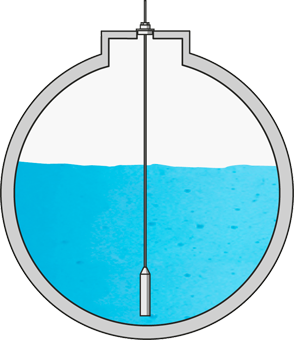Sensors: hydrostatic pressure
Hydrostatic pressure gauges are a popular option for tank level measurement. They sit at the bottom of the tank, sense the pressure applied to a flexible diaphragm, and convert this into an electrical signal you can read. Hydrostatic pressure gauges can be less expensive than non-contact options.
Hydrostatic pressure gauges measure pressure (the weight of the product above the sensor), not volume. A system like HyDip coverts the reading into quantity by virtue of a calibration procedure and a height to volume conversion ("strapping") table specific to the tank.

A Vegawell 52 pressure sensor in a water tank, with a cable running up to the roof. This can be connected to a HyDip device located nearby, to send readings to an online account on your laptop.
Other considerations
As well as products like diesel, you can use pressure gauges for liquids that don't have a distinct surface. This makes them suitable for tanks holding waste, or any liquid that tends to foam.
Pressure gauges are not suitable for powders or solids, as the weight of the product may not transmit itself to the sensor evenly.
At a constant temperature weight is proportional to volume. However, as your tank passes from the cool of the night to the heat of the day the product will typically expand as density drops. This means that the volume of your liquid will increase slightly, while the weight measured by your pressure sensor will stay the same. This means that unlike ultrasonic or radar distance sensors, daily movements in density/height caused by temperature fluctuations are generally not visible with hydrostatic gauges.
Updated 10 months ago
